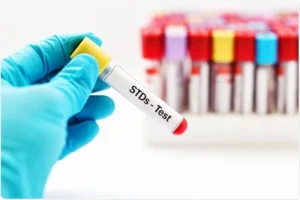The relationship between herpes viruses and humans may have been around for thousands of years. Herpesviruses have a unique structure with four layers: a nucleus containing a large DNA genome and two strands bound by icosahedral capsid. The capsid is surrounded by a protein coating called the tegument. It is enclosed in an envelope containing a lipid bilayer that carries glycoprotein. Any of the several herpesvirus infections are characterized by blisters or rashes on skin or mucous membranes.
Herpes genitalis is a sexually transmitted disease caused by the herpes simplex virus (HSV). It is a DNA virus with two serotypes: herpes simplex virus 1 (HSV-1) and herpes simplex virus 2 (HSV-2). Both of these types can cause sores on the inside and back of your vagina, cervix, anus, penis, skin, buttocks, inner thighs, lips, mouth, throat, and it is rare for your eyes. HSV-1 oral herpes can spread from the mouth to the vagina through oral sex. This is why some cases of herpes genitalis are due to HSV-1.
Herpes is non-lethal and usually does not cause serious health problems. While herpes outbreaks can be irritating and painful. There are ways to treat herpes, and precautions to make sure you do not give herpes to anyone you have sex with.
-
HSV-1 (Oral Herpes)
It is usually responsible for cold sores and fever blisters around the mouth and face. Children often get HSV-1 from close contact with an infected adult person.
The following interactions can cause HSV-1:
- by eating in the same utensils
- kissing
- sharing lipstick or lip balm
The virus spreads very quickly when an outbreak occurs.
What are the signs and symptoms of HSV-1?

Most blisters appear on the lips or mouth. Sometimes blisters form on the face or tongue. These are the common places to get oral herpes. The blisters will leak fluid into the sores. After about four to six days, the sores will start to crack and heal. However, some people show no symptoms at all.
Preventive measures for HSV-1 (Oral Herpes)
- Apply sunscreen or lip balm containing zinc oxide to your lips regularly.
- Apply a lotion to prevent the lips from becoming too dry.
- Avoid direct contact with herpes sores.
- Wash items such as towels in boiling water after each use.
- Do not share utensils, threads, glasses, or other items if someone suffering from herpes
Testing for HSV-1?
Polymerase Chain Reaction (PCR), blood test, or biopsy can confirm HSV-1. PCR is a popular test to detect herpes infections. If you think you may have a herpes infection, a home test may be the easiest option for you. If you have the herpes virus and its antibodies, it can be found in a blood test, even if you have no symptoms. However, the only time a virus may not be detected in a test (after contraction) is if it is tested early.
-
HSV-2 (genital Herpes)
Herpes simplex virus 2 (HSV-2) infection is widespread and almost exclusively sexually transmitted, causing genital herpes. A person can contact herpes 2 infections during sexual contact or skin-to-skin contact with a person with genital HSV-2 infection.
What are the signs & symptoms of HSV-2?
Symptoms can begin about two to 12 days after exposure to the virus. HSV-2 causes itching and sores in the genital area. However, at times you may not have any signs or symptoms of genital herpes. An infected person does not always have visible sores. Sores can develop when blisters rupture and come out or bleed. Sores can make it difficult to urinate. During the first rash, you may have flu-like symptoms such as swollen lymph nodes in your grip, head, muscles, and fever.
Preventive measures of HSV-2 (Genital Herpes)
Suggestions for the prevention of genital herpes are similar to preventing other sexually transmitted infections. Avoid having sex. or Limit sexual contact. In short, you can:
- Use a latex condom during all sexual intercourse
- Avoid having sex if any infected partner.
- Be in a long-term relationship with one person who does not have an STD (e.g., a partner who has been tested and has the negative test).
Testing for HSV-2?
An HSV-2 biopsy can help determine if you have got herpes. HSV-2 tests are usually are only for genital sores. Tests can even be performed using other kinds of samples, like bodily fluid, blood, urine, or tears. To determine if the sores are due to HSV-2, a variety of tests are out there.
Conclusion
For many couples, herpes is not a big deal. Try to talk about it. It is better to have a conversation calmly HSV is a common virus. According to the World Health Organization (WHO) Trusted Source, about 67% of people worldwide have HSV-1, and 11% have HSV-2. A Home Herpes Test is an efficient way for those who are uncomfortable to discuss sensitive topics such as these in-person with their medical providers who do not agree with a non-infectious diagnosis. Using a new male or female condom or rubber dental dam every time you have vaginal or oral sex will reduce the risk of herpes transmission. While having sex with multiple partners, it is even more important to use condoms and regular STI tests. If you have genital herpes you shall test for other sexually transmitted infections, as well, to ensure safety.




